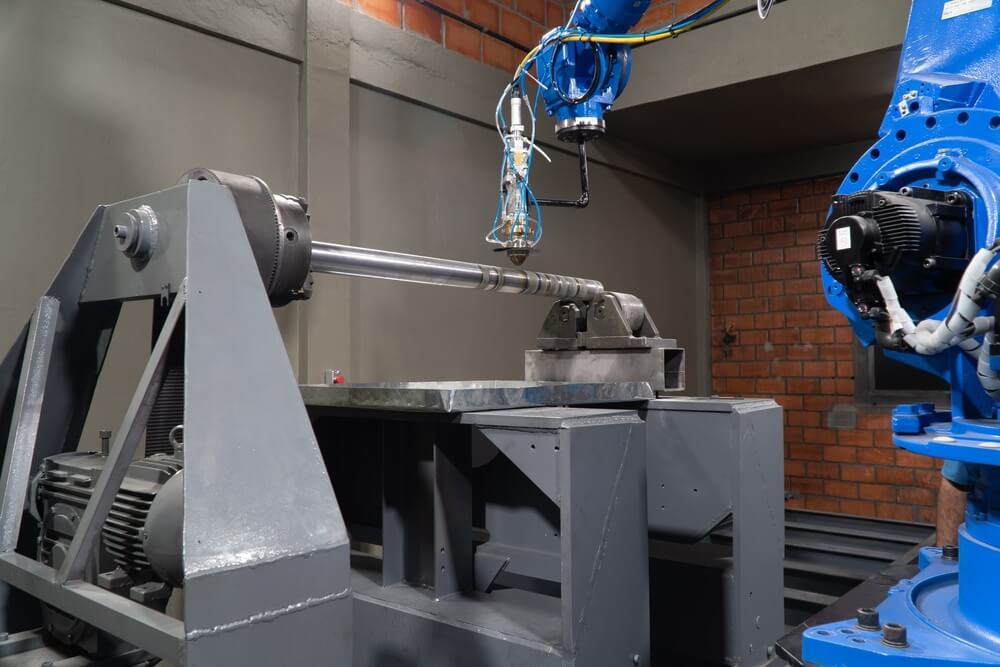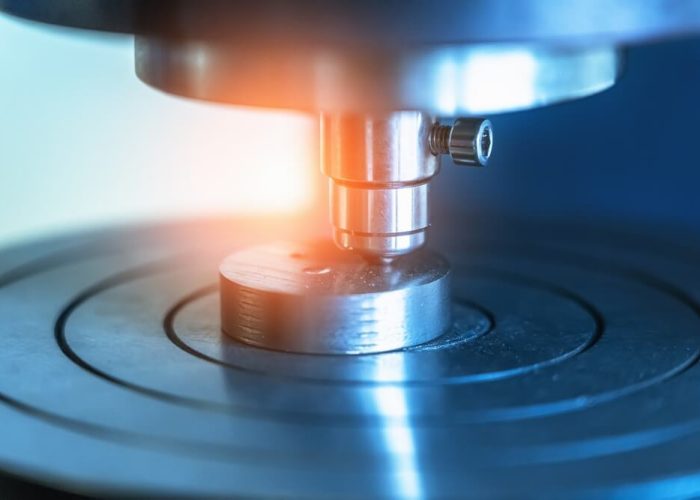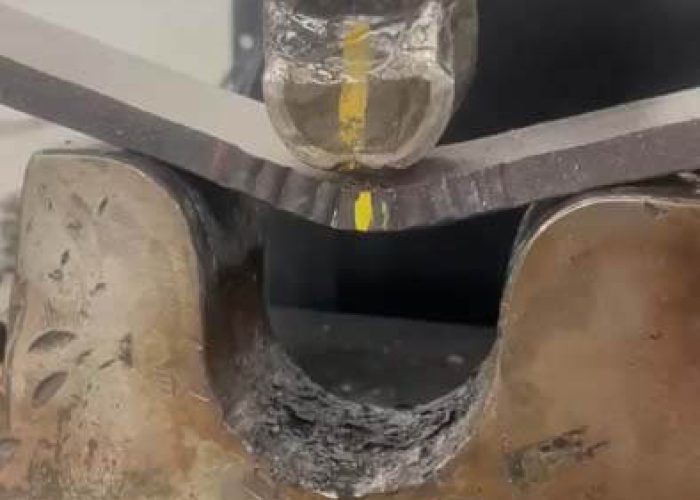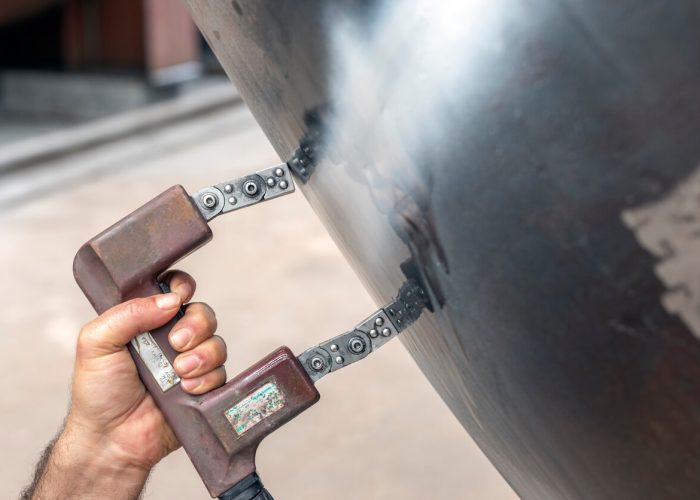Clad Welding: Techniques, Applications, and Benefits
Clad welding, also known as cladding, is a process of joining two dissimilar metals to create a new material with enhanced characteristics, such as corrosion resistance or wear resistance. This technique is commonly used in industries such as oil and gas, chemical processing, and power generation for components like pipes, valves, and vessels.

How to Apply Clad Welding
Clad welding may seem complex, but let’s break it down into manageable steps. First, we start with surface preparation, crucial to ensure a strong bond between the cladding material and the base material.
Step I – Surface Preparation
Before applying any cladding material, it’s important to thoroughly clean the base material to remove impurities such as oil, rust, or dirt. We use an abrasive blasting technique to create a pristine surface for the clad material to bond with. This technique involves shooting abrasive materials at high velocity against the surface using compressed air. It ensures that the surface is free from contaminants, promoting better adhesion and integrity of the clad layer.
Step II – Choosing the Right Welding Method
Selecting an appropriate clad welding method is critical as it directly influences the quality and performance of the cladding. Several common methods are used in clad welding, each with its own advantages and considerations. For instance, Submerged Arc Welding (SAW) is often used for its high deposition rates, making it suitable for thicker cladding layers. Gas Metal Arc Welding (GMAW) offers excellent control over the welding process and is well-suited for moderate thicknesses. Laser Cladding provides precision and minimal heat input, ideal for intricate geometries.
The choice of method depends on factors such as the desired cladding thickness, material compatibility, and specific application requirements.
Step III – Applying the Cladding Material
Using a suitable welding machine, we carefully apply the cladding material onto the prepared base material. Precision and consistency are crucial in this step to ensure an even distribution of the cladding material. The goal is to achieve a uniform layer that firmly adheres to the base material.
Step IV – Post-Weld Treatment
After applying the cladding material, conducting post-weld heat treatment (PWHT) becomes essential. PWHT helps relieve residual stresses developed during the welding process and enhances the metallurgical properties of the clad layer. This treatment contributes to improved mechanical properties and corrosion resistance of the cladded surface.
Following PWHT, a thorough inspection is conducted to verify the quality of the weld. This may involve non-destructive testing methods such as ultrasonic testing or radiography to ensure that the clad layer meets specified standards and performance criteria.
By carefully following these steps, we can ensure that clad welding is executed with precision and attention to detail, ultimately leading to robust and durable clad structures with exceptional performance characteristics.
By meticulously following these steps from surface preparation to post-weld treatment, you can masterfully craft robust clad structures ready to meet even the most demanding industrial challenges.
Methods and Techniques
Submerged Arc Welding (SAW) is well-known for its high efficiency in large-scale production. This method is particularly favored due to its ability to provide deep weld penetration and high deposition rates, making it an ideal choice for welding thick materials. By using a granular flux as a blanket, this technique protects the weld metal from atmospheric contamination, resulting in high-quality welds with reduced spatter levels, which enhance overall welding efficiency.
Moreover, SAW offers exceptional efficiency when working on thick elements, such as heavy plates and pipes. The automated nature of the process allows for consistent and uniform results, contributing to its reliability in industrial settings. This method minimizes the need for post-weld cleaning or extensive refinement due to the controlled welding environment, further streamlining the overall production process.
Gas Metal Arc Welding (GMAW)
Gas Metal Arc Welding (GMAW), also known as MIG/MAG welding, stands out for its versatility in handling a wide range of materials and thicknesses. As a semi-automatic or automatic welding process, it uses a continuous solid wire electrode and a shielding gas to protect the weld area from atmospheric contamination. This technique provides extensive control over the weld bead and weld pool, allowing for precise and well-defined welds.
For industries requiring adaptable solutions for dissimilar metals and varying material thicknesses, GMAW becomes an indispensable option. Its ease of use makes it suitable for both beginners and experienced welders, ensuring consistency and quality in welded joints across different applications.
Laser Cladding
Laser cladding utilizes a focused laser beam to deposit specialized metal coatings onto a substrate surface. This technique ensures exceptional precision, minimal heat input, and negligible thermal distortion during the process. As a result, laser cladding is particularly useful in applications that demand high accuracy and minimal dilution or alteration of the base material.
Industries with stringent requirements for surface quality, such as aerospace and medical device manufacturing, greatly benefit from laser cladding due to its ability to apply thin coatings with minimal impact on the substrate material. Additionally, the absence of filler materials results in decreased material wastage and enhanced cost-effectiveness in specific production scenarios.
Each of these techniques offers unique advantages that cater to different industrial demands and material specifications. The proper selection of clad welding methods plays a crucial role in achieving efficient and high-quality outcomes across diverse applications.
By understanding these distinct methods and techniques, industries can leverage their strengths to address specific welding challenges and optimize production processes accordingly.
Benefits of Clad Welding
Let’s step back for a moment and appreciate the remarkable advantages that clad welding offers. It’s not just about creating a strong bond between dissimilar metals or alloys; it brings about several other key benefits that significantly impact the performance, lifespan, and financial aspect of industrial components.
First and foremost, enhanced corrosion resistance is one of the primary reasons why clad welding is widely adopted. The application of a corrosion-resistant layer over a base metal helps protect it from harsh chemical and atmospheric conditions, thereby prolonging its service life and reducing maintenance costs. This means components are less likely to corrode when exposed to aggressive environments, ensuring they remain structurally sound and maintain their performance over an extended period.
Furthermore, clad welding presents exceptional opportunities for cost efficiency. By using a small amount of expensive, corrosion-resistant material on the outer layer while applying it over a cheaper yet robust base metal, substantial cost savings can be achieved without compromising performance or quality. This results in a win-win situation by providing durable components at a reduced overall cost.
In addition to that, another significant benefit comes in the form of improved mechanical properties. Through clad welding, the mechanical properties of the base material can be significantly enhanced. This includes increased wear resistance and higher hardness, making the components more durable and long-lasting. Such improvements are especially crucial in applications where components are subjected to abrasive wear, high pressures, or extreme temperatures.
As we explore these benefits further, we gain a deeper understanding of how clad welding elevates the performance and longevity of industrial components while simultaneously offering compelling economic advantages.
By gaining an appreciation for the benefits of clad welding, it becomes clear that this technique plays a crucial role in enhancing industrial component performance.
Common Materials Used
In our industry, various materials are used in clad welding, each chosen for their unique properties and characteristics. Let’s explore a few common ones:
Stainless Steel
Stainless steel is a popular choice due to its exceptional corrosion resistance properties. This material is particularly prized in industries such as chemicals and petrochemicals where exposure to corrosive environments is high. The use of stainless steel in clad welding helps protect underlying components and structures, increasing their longevity and reliability.
Nickel Alloys
Nickel alloys are another key player in clad welding, valued for their incredible strength and ability to withstand extreme temperatures. These properties make them ideal for applications that require durability under harsh conditions, such as aerospace, power generation, and oil refining. By using nickel alloys in clad welding, we are able to enhance the performance and longevity of critical components.
Copper and Copper Alloys
Copper and its alloys find extensive use in the electrical and heat exchanger industries due to their excellent thermal and electrical conductivity. When incorporated into clad welding processes, copper materials ensure efficient heat transfer and electrical conduction, making them indispensable for a wide range of industrial applications.
We rely on these materials as the building blocks for creating composite structures with superior properties, ultimately contributing to enhanced performance across various industries.
The careful selection of these materials is not only essential for achieving desired functional properties but also plays a critical role in ensuring the longevity and effectiveness of clad welded components.
Practical Applications
Clad welding is like the unsung hero of the welding world. This specialized and advanced process isn’t flashy, but its impact is felt across a wide range of industries, quietly making components and structures more resilient in harsh environments. Let’s explore how different industries benefit from the unique properties of clad welding.
Oil and Gas Industry In the oil and gas industry, integrity is everything. It’s essential to protect pipelines, pressure vessels, and other components from corrosion, wear, and extreme environmental conditions. Clad welding is extensively used to do just that, providing an extra layer of protection to ensure the longevity and performance of these critical assets.
Power Generation Efficiency and durability are paramount in power generation. Turbine blades and other critical components operate under high temperatures and harsh conditions which makes them vulnerable to wear and corrosion. Clad welding allows for the application of specialized materials with superior wear and corrosion resistance, enhancing the performance and longevity of these crucial components.
Chemical Processing Reactors and storage tanks in chemical plants are constantly exposed to aggressive chemicals and high temperatures. Clad welding plays a vital role in protecting these structures against corrosion, erosion, and high-temperature degradation.
It’s remarkable how clad welding doesn’t address immediate concerns but also contributes to the overall safety and reliability of industrial processes. The ability of cladding to mitigate the detrimental effects of harsh operating conditions cannot be overstated. In each industry application, clad welding goes beyond mere surface protection; it serves as a shield that ensures the consistent performance and long-term resilience of critical components.
These practical applications underscore how clad welding fundamentally transforms ordinary components into durable assets that thrive in demanding environments. Its versatility extends across industries, safeguarding equipment against the ravages of time and facilitating smooth operations even under challenging circumstances.
Limitations and Challenges
Clad welding indeed brings a wealth of benefits, yet it’s not without its set of challenges. From high initial costs to quality control complexities and material compatibility issues, several aspects need careful consideration when working with clad welding techniques.
High Initial Costs
The upfront investment in equipment and materials for clad welding can be substantial. Specialized machinery, high-quality cladding materials, and skilled labor all contribute to these initial costs. While this may seem overwhelming initially, it’s important to remember that these expenses balance out through the long-term benefits of improved component performance, longevity, and reduced maintenance needs.
Complexity in Quality Control
Ensuring a defect-free clad layer demands rigorous inspection and testing. This goes beyond surface visual inspection and extends to employing advanced non-destructive testing (NDT) techniques like ultrasonic testing and radiographic inspection. These methods play a crucial part in detecting internal defects within the clad layer, preserving the high quality, and integrity of the weld.
Potential for Material Compatibility Issues
One challenge inherent in clad welding is the potential for material compatibility issues. Not all base materials and cladding metals are compatible, which can lead to bonding problems if not carefully selected and tested. For instance, certain combinations may be prone to delamination or cracking, compromising the overall structural integrity of the weld.
It’s crucial to carefully evaluate the compatibility of base and cladding materials before embarking on any clad welding project. Thorough testing and analysis should be conducted to ensure that the chosen materials will work seamlessly together, preventing any potential complications down the line.
Understanding these limitations and challenges allows us to approach clad welding with a thorough understanding of what is required, enabling us to anticipate potential issues and implement strategies for mitigating them effectively.
Industry Case Studies
Offshore oil rigs, the workhorses of the oil and gas industry, endure some of the harshest environmental conditions on the planet. The corrosive nature of saltwater, along with constant exposure to wind and waves, wreaks havoc on traditional steel structures. This was a persistent headache for the industry, but since the adoption of clad welding, things have changed dramatically.
Offshore oil rigs constructed with clad welding techniques have proven to be more resilient and longer-lasting. The cladding of crucial structural components provides superior resistance to corrosion and erosion, resulting in reduced downtime and maintenance costs. This translates into immense financial savings for oil companies as they no longer need to perform frequent repairs or replacements due to deteriorating materials. The use of clad welding has ushered in a new era of durability for offshore rigs, ensuring reliability amidst the most unforgiving environments.
Nuclear Power Plants
When it comes to nuclear power plants, safety and longevity are paramount concerns. Clad welding plays a vital role in safeguarding critical components against radiation and corrosion. The nuclear industry relies on this advanced technique to ensure that essential parts retain their structural integrity, even in the face of extreme conditions.
Clad welding has proven indispensable in protecting these sensitive components, aiding nuclear power plants’ safe operation over extended periods. This approach allows for minimal degradation and ensures that crucial equipment stands up to the harsh internal environment, paving the way for longer-term operation and improved safety standards within nuclear facilities.
These case studies vividly showcase how clad welding has not just become a fabrication method, but a transformative force across industries. Its influence spreads far and wide, from offshore petroleum extraction to safer nuclear power generation, profoundly impacting the reliability and efficiency of critical infrastructure.
The evolution of clad welding has shown how technological advancements revolutionize industrial practices to meet ever-increasing demands.
Future Innovations in Clad Welding
The future of clad welding is undergoing an incredible transformation, thanks to remarkable technological advancements. Three pivotal areas that fuel this development are advanced robotics and automation, new material combinations, and sustainable practices.
Advanced Robotics and Automation
Clad welding stands to benefit significantly from the integration of advanced robotics empowered by AI, ensuring higher precision, consistency, and productivity. These robotic systems offer unparalleled opportunities to drive significant progress by improving upon human movement with near-perfect precision and repeatability, ultimately enhancing productivity and efficiency in complex or large-scale applications.
New Material Combinations
The incessant pursuit of innovation in clad welding is driven by the variety of materials at our disposal. Researchers continually seek to expand the range of applications for clad welding by developing new alloys and material combinations, significantly impacting numerous sectors such as energy production and manufacturing.
Sustainable Practices
In response to global sustainability initiatives, innovations aimed at reducing waste and energy consumption in the clad welding process are gaining momentum. From waste reduction initiatives to energy-efficient practices within clad welding processes, every positive change contributes to a collective effort to build a greener future.
These exciting advancements are setting the stage for a remarkable evolution of clad welding, transforming industrial processes and shaping a more sustainable and efficient future for generations to come. For more detailed insights and quality testing services in this field, visit WH Labs.
What are the advantages and disadvantages of clad welding compared to other welding techniques?
Clad welding offers several advantages compared to other welding techniques. Firstly, it allows the combination of different materials with distinct properties, enhancing overall performance and durability. Secondly, the precise control over the thickness of the cladding layer provides versatility and cost-effectiveness. Additionally, clad welding minimizes heat-affected zones, reducing distortion and maintaining material integrity. However, a disadvantage is that clad welding may require more complex equipment, and specialized skills compared to traditional welding methods.
How does clad welding differ from other types of welding, such as TIG or MIG welding?
Clad welding differs from other types of welding, such as TIG or MIG welding, primarily in terms of the materials involved. While TIG and MIG welding focus on joining similar metals, clad welding involves bonding two different materials together. This technique offers a range of benefits, including enhanced corrosion resistance, improved durability, and increased strength. According to industry statistics from 2023, clad welding has gained popularity due to its ability to create high-quality joints in critical applications where dissimilar metals are required.
What industries or applications commonly use clad welding?
Clad welding is commonly used in various industries such as oil and gas, nuclear power, chemical processing, and aerospace. In the oil and gas industry, clad welding is utilized for the fabrication of corrosion-resistant pipes and equipment, ensuring long-term durability in harsh environments. Similarly, in nuclear power plants, clad welding plays a crucial role in the construction of reactor components to withstand high temperatures and corrosive conditions. Statistics show that the global clad welding market is expected to reach USD 8.56 billion by 2025, highlighting its widespread use and importance across different sectors.
Can clad welding be used on different types of materials, such as metals and non-metals?
Yes, clad welding can be used on different types of materials, including metals and non-metals. Clad welding involves combining multiple layers of different materials to create a composite structure with desired properties. It offers benefits such as improved corrosion resistance, increased strength, and enhanced wear resistance. According to industry statistics, the global market for clad welding is projected to grow at a CAGR of 5.6% from 2021 to 2028, further indicating its versatility and widespread application across various material types.
Are there any specific safety precautions or certifications required for clad welding?
Yes, there are specific safety precautions and certifications required for clad welding. Welders must undergo appropriate training and be certified in order to ensure that they have the necessary skills and knowledge to safely perform clad welding. This includes understanding the risks associated with welding, using proper personal protective equipment (PPE) such as welding helmets and gloves, and following established safety procedures. According to industry statistics from the American Welding Society (AWS), certified welders have a lower incidence of accidents and injuries compared to non-certified welders, highlighting the importance of these safety measures in the field of clad welding.



